Old Money from The Peoples National Bank Of Warrensburg
The Peoples National Bank Of Warrensburg in Missouri printed $1,156,790 dollars worth of national currency. Over $1,000,000 face value is a lot of money. However, some types and denominations of currency from this bank could still be rare. This national bank opened in 1898 and stopped printing money in 1935, which equals a 38 year printing period. That is a fairly normal lifespan for a national bank. During its life, The Peoples National Bank Of Warrensburg issued 13 different types and denominations of national currency. We have examples of the types listed below. Your bank note should look similar. Just the bank name will be different. For the record, The Peoples National Bank Of Warrensburg was located in Johnston County. It was assigned charter number 5156.
We buy all national currency. Please call or email us for a quote. Sales@AntiqueMoney.com
The Peoples National Bank Of Warrensburg in Missouri issued 1,750 sheets of $5 - 1882 brown back national bank notes. That sheet output number is small. Don’t expect too many of these to be available to collectors. You can take the total number of sheets printed and multiply that number by four to get the exact number of 1882 $5 brown back bank notes this bank issued. Each note has a portrait of James Garfield on the left hand side of the bill. These are very popular with collectors because they have different text layouts. Some notes are worth as little as a few hundred dollars, but most are worth a good deal more.
Series of 1882 $5 Brown Back
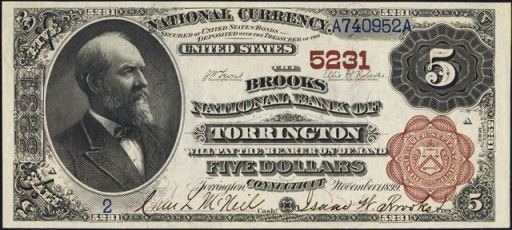
The Peoples National Bank Of Warrensburg printed 3,750 sheets of $10 1882 brown back national bank notes. That it is not an exceptionally low number of sheets. However, you have to remember that we are talking about bank notes printed before 1902. Even a large print number could have a very low survival rate. There were three $10 bills printed on a single sheet of 1882 brown backs. The design of the bill is similar to all earlier ten dollar national bank notes. The nickname comes from the fact that these bills have a brown seal and brown overprint. Despite saying series of 1882, these were actually printed by some banks up until 1908. The date you see in cursive relates to when the bank first started issuing brown back notes.
Series of 1882 $10 Brown Back
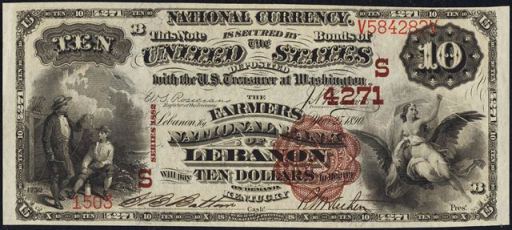
The Peoples National Bank Of Warrensburg also printed 3,750 sheets of $20 1882 brown back national bank notes. As you can see, the sheet output is the same for $20 brown backs as it is for $10 brown backs. There was only one $20 brown back printed on a sheet. So the sheet output also equals the total note output. One neat thing about all brown backs is that they each have a different back design based on which state issued them. The back left hand side of the note shows the state seal of which ever state the national bank was located in. Generally speaking, 1882 $20 brown backs are pretty difficult to locate. They typically were printed in small numbers and they don’t have a great survival rate.
Series of 1882 $20 Brown Back
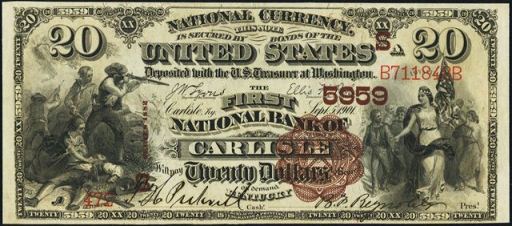
The Peoples National Bank Of Warrensburg also printed 6,445 sheets of $5 1882 blue seal national bank notes. That is a pretty standard sheet output number for these issues. Most of the value is going to be in the condition. 1882 $5 blue seal bank notes were issued by some national banks in The United States. While these are a somewhat rarer issue, they just aren’t especially popular with collectors. With exception of some minor differences, they look exactly like the earlier brown back series. Most collectors would prefer the brown back notes. With that said, some 1882 blue seals can still be worth thousands of dollars. So don’t just assume that what you have is automatically common.
1882 Blue Seal $5 National Bank Note
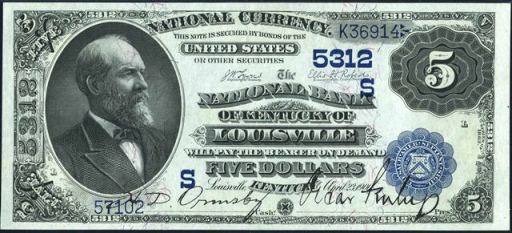
The Peoples National Bank Of Warrensburg also printed 4,007 sheets of $10 1882 blue seal national bank notes. That is a pretty standard sheet output number for these issues. Most of the value is going to be in the condition. All of these notes say series of 1882 but they were actually printed between 1908 and 1921. So they aren’t quite as old as the dates might suggest. There is also a date on these notes that is between 1888 and 1901. That date is written in cursive text and it represents when the bank was chartered or re-chartered. Some of the so called 1882 value back notes have a chance to be really rare. Most of the earlier notes that say 1882-1908 on the back are likely going to be relatively common. The designs are exactly the same on the front. Each has a blue seal and charter number.
1882 Blue Seal $10 National Bank Note
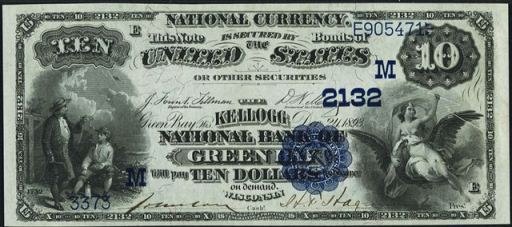
The Peoples National Bank Of Warrensburg also printed 4,007 sheets of $20 1882 blue seal national bank notes. That is the same number of sheets as the ten dollar denomination. You don’t have to multiply by three to get the exact number of notes issued though. There was only one twenty dollar bill per sheet. As with any national bank note, the exact value is still based on the condition, serial number, and bank of issue.
1882 Blue Seal $20 National Bank Note
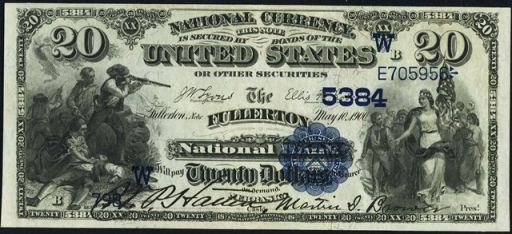
The Peoples National Bank Of Warrensburg also printed 19,324 sheets of $5 1902 blue seal national bank notes. Once a bank prints more than 10,000 sheets of blue seals it becomes very difficult for those notes to be rare. Ben Harrison is on the front of all 1902 $5 blue seal bank notes. This happens to be the smallest denomination issued for the 1902 series. Each note is complete with a blue seal and blue charter number. Despite saying series of 1902, these were actually issued by national banks between 1908 and 1928. There are two different types of blue seals. The first type is called a date back and it has “1902-1908” written on the back of the bill. The other type is called a plain back; it does not have the date stamps on the back of the bill. The values for these notes range widely based on condition and the bank of issue.
1902 $5 Blue Seal National Bank Note
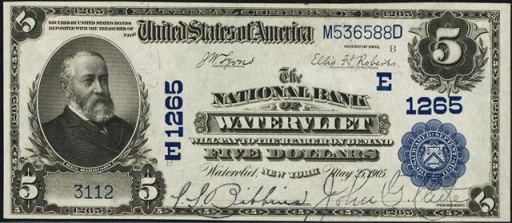
The Peoples National Bank Of Warrensburg also printed 2,940 sheets of Type1 1929 $5 national bank notes. That is a pretty typical sheet output for a national bank during the small size era. Every 1929 $5 bill has a portrait of Abraham Lincoln on it. This is also the lowest denomination of small size national currency that any bank issued. All serial numbers end with the letter A and start with a letter between A and F. Remember that you can take the total number of sheets printed and multiply it by six get to the actual number of bank notes printed for this denomination. All small size national bank notes were printed on sheets of six.
Series of 1929 Type1 $5 National Bank Note
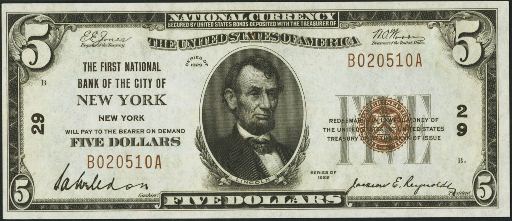
The Peoples National Bank Of Warrensburg also printed 960 sheets of Type1 1929 $10 national bank notes. This is a small print range, but it does not guarantee rarity. Each $10 bill from 1929 has a portrait of Alexander Hamilton on it. The black number written vertically is the charter number. The charter number never affects the value; it is just an identifier. The ten dollar type1 national bank note happens to be the single most common national bank note, with over 65,000 known to exist from all banks. Of course each note is valued based on its condition and rarity. Some are very rare.
Series of 1929 Type1 $10 National Bank Note
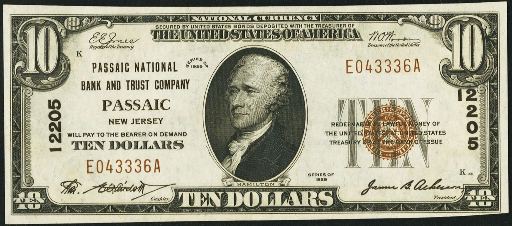
The Peoples National Bank Of Warrensburg also printed 234 sheets of Type1 1929 $20 national bank notes. That may sound like a very small number, and it is. However, when it comes to small size notes, that print range usually allows for a handful of survivors. Andrew Jackson is featured on the front of each 1929 $20 bill. Be sure to take note of the serial number on your specific bank note. If it is 000001 then you can expect a nice premium. There is a special market for serial number one bank notes. Of course, even if the number isn’t #1, it could still be collectible and have a high value just based on its condition and rarity alone.
Series of 1929 Type1 $20 National Bank Note
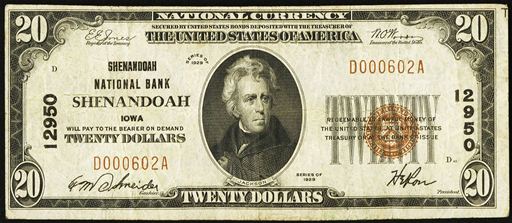
The Peoples National Bank Of Warrensburg also printed 2,498 individual notes from the type2 1929 $5 national bank note series. That may seem like a high number, but remember that is total notes printed for the denomination, not sheets printed. This was an easy and popular denomination for national banks. Five dollars could buy a lot of different things back in 1929 and the early 1930s. 1929 type2 five dollar bank notes are available in quantities today. However, some notes can be extremely rare. The exact value all depends on the bank of issue and condition. Contact us and we would be happy to give a free appraisal.
Series of 1929 Type2 $5 National Bank Note
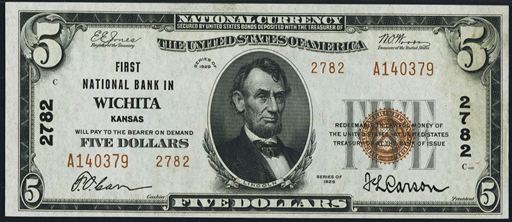
The Peoples National Bank Of Warrensburg also printed 2,295 individual notes from the type2 1929 $10 national bank note series. That may seem like a high number, but remember that is total notes printed for the denomination, not sheets printed. The easiest way to spot the difference between type1 1929 $10 bills and 1929 type2 $10 bills is in the serial number. Type2 notes have a serial number that ends with a number. 1929 type1 notes have a serial number that ends with the letter A. Generally speaking, these $10 bills are rarer than the earlier type1 issues. However, most collectors don’t pay more for that rarity because they look basically the same.
Series of 1929 Type2 $10 National Bank Note
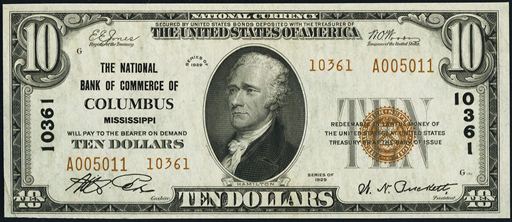
The Peoples National Bank Of Warrensburg also printed 462 individual notes from the type2 1929 $20 national bank note series. Type2 1929 national bank notes are already rare to begin with. A printing of less than 1,000 is especially low. One of the great things about 1929 type2 $20 national bank notes is that they really aren’t that old and some can be extremely rare. Until the big head $20 series started there really wasn’t much difference between something printed in 1929 and the same bill printed in 1993.
Series of 1929 Type2 $20 National Bank Note
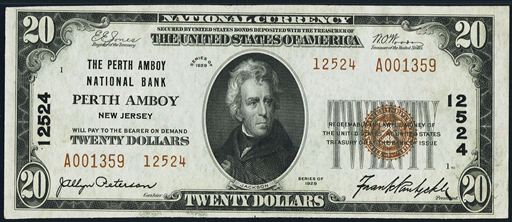


No comments:
Post a Comment